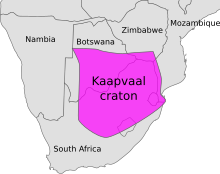Kaapvaal Craton
This article may be too technical for most readers to understand. (January 2013) |

The Kaapvaal Craton (centred on Limpopo Province in South Africa), along with the Pilbara Craton of Western Australia, are the only remaining areas of pristine 3.6–2.5 Ga (billion years ago) crust on Earth. Similarities of rock records from both these cratons, especially of the overlying late Archean sequences, suggest that they were once part of the Vaalbara supercontinent.[1]
Description
The Kaapvaal Craton covers an area of approximately 1,200,000 km2 (460,000 sq mi) and is joined to the Zimbabwe Craton to the north by the Limpopo Belt. To the south and west, the Kaapvaal Craton is flanked by Proterozoic orogens, and to the east by the Lebombo monocline that contains Jurassic igneous rocks associated with the break-up of Gondwana.[2]
The Kaapvaal Craton formed and stabilised between 3.7 and 2.6 Ga
Late Archean metamorphism joined the Southern Marginal Zone of the Kaapvaal Craton to the Northern Marginal Zone of the Zimbabwe Craton approximately 2.8–2.5 Ga by the 250 kilometres (160 mi) wide orogenic Limpopo Belt. The belt is an east-northeast trending zone of granulite facies tectonites that separates the granitoid-greenstone terranes of the Kaapvaal and Zimbabwe cratons.
Limpopo Central Zone
The crustal evolution of the Limpopo Central Zone can be summarised into three main periods: 3.2–2.9 Ga, 2.6 Ga, and 2.0 Ga. The first two periods are characterised by magmatic activity leading to the formation of Archaean
There is no indication that the
Barberton greenstone belt
The Barberton greenstone belt, also known as the
Johannesburg Dome
The Archaean Johannesburg Dome is located in the central part of the Kaapvaal Craton and consists of trondhjemitic and tonalitic granitic rocks intruded into mafic-ultramafic greenstone.[2] Studies using U-Pb single zircon dating for granitoid samples yield an age of 3340 +/- 3 Ma and represents the oldest granitoid phase recognised so far. "Following the trondhjemite-tonalite gneiss emplacement a further period of magmatism took place on the dome, which resulted in the intrusion of mafic dykes that are manifest as hornblende amphibolites. The age of these dykes has yet to be determined quantitatively, but they fall within the time constraints imposed by the age of the trondhjemitic gneisses (3340–3200 Ma) and later, crosscutting, potassic granitoids.
These rocks consisting mainly of granodiorites constitute the third magmatic event and occupy an area of batholithic dimensions extending across most of the southern portion of the dome. The southern and southeastern parts of the batholith consist mainly of medium-grained, homogeneous, grey granodiorites dated at 3121 +/- 5 Ma....The data, combined with that from other parts of the Kaapvaal craton, further supports the view that the evolution of the craton was long-lived and episodic, and that it grew by accretionary processes, becoming generally younger to the north and west of the ca. 3.5 Ga Barberton- Eswatini granite-greenstone terrane situated in the southeastern part of the craton."[5]
See also
- Archean life in the Barberton Greenstone Belt – Some of the most widely accepted fossil evidence for Archean life
- Vaalbara – Archaean supercontinent from about 3.6 to 2.7 billion years ago
- Vredefort impact structure – Largest verified impact structure on Earth, about 2 billion years old
References
- ^ Zegers, T.E., de Wit, M.J., Dann, J. and White, S.H. (1998) "Vaalbara, Earth's oldest assembled continent? A combined, structural, geochronological, and palaeomagnetic test", Terra Nova, 10, 250–259.
- ^ a b c Nguuri, T.K. et al. (2001) “Crustal structure beneath southern Africa and its implications for the formation and evolution of the Kaapvaal and Zimbabwe cratons”, "Geophysical Research Letters", 28, 2501–2504.
- ^ Chavagnac, V., Kramers, J. D. and Naegler, T. F. (1999) "Can we Still Trust Nd Model Ages on Migmatized Proterozoic Rocks?", Early Evolution of the Continental Crust, Journal of Conference Abstracts, 4 (1), A08:4A:13:G2.
- ^ Beukes, N.J., Dorland, H.C., Gutzmer, J., Evans, D.A.D. and Armstrong, R.A. (2004) "Timing and Provenance of Neoarchean-Paleoproterozoic Unconformity Bounded Sequences on the Kaapval Craton" Archived 13 November 2007 at the Wayback Machine, Geological Society of America Abstracts with Programs, 36 (5), 255.
- .
Bibliography
- Glikson, A. and Vickers, J. (2006) "The 3.26–3.24 Ga Barberton asteroid impact cluster: Tests of tectonic and magmatic consequences, Pilbara Craton, Western Australia", Earth and Planetary Science Letters, 241 (1–2), 11–20,
- Louzda, K.L. (2003) "The magmatic evolution of the upper ~3450 Ma Hooggenoeg Formation, Barberton greenstone belt, Kaapvaal Craton, South Africa", Utrecht University : unpubl. MSc project abstr.
- Poujol, M., Robb, L.J., Anhaeusser, C.R. and Gericke, B. (2003) "A review of the geochronological constraints on the evolution of the Kaapvaal Craton, South Africa", Precambrian Research, 127 (1–3), 181–213, .
- Westraat, J.D, Kisters, A.F.M., Poujo, M. and Stevens, G. (2005) "Transcurrent shearing, granite sheeting and the incremental construction of the tabular 3.1 Ga Mpuluzi batholith, Barberton granite–greenstone terrane, South Africa", Journal of the Geological Society, 162 (2), 373–388,
- Yearron, L.M., Clemens, J.D., Stevens, G. and Anhaeusser, C.R.(2003) "Geochemistry and Petrogenesis of the Granitoids of the Barberton Mountainlan, South Africa", Geophysical Research Abstracts, 5, 02639
